How to understand how much you are worth, or payroll clusters in action!
Most recently, we otrelysili salary clusters on hh.ru , which help to evaluate their value as a specialist. This is a rather interesting and flexible feature, such that with its help you can even conduct a small study of the labor market, defining your place in it:
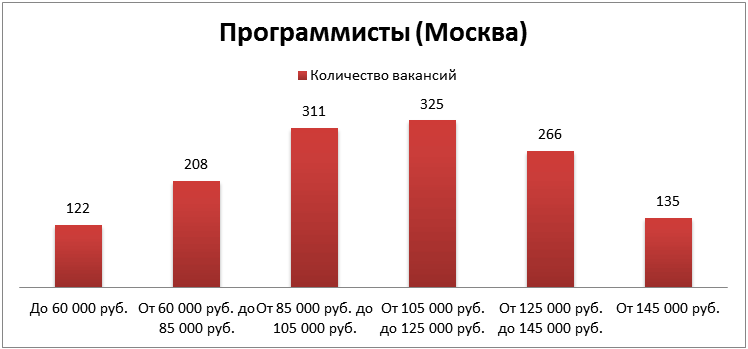
Now in the IT labor market, applicants rule: it is enough to open your resume and immediately get a lot of offers. Our hh.index , which shows the ratio of the number of summaries to the number of vacancies, in the field of information technology in July fell in Moscow to a record value of 1.2 (at the peak in 2009, its value rose above 3):
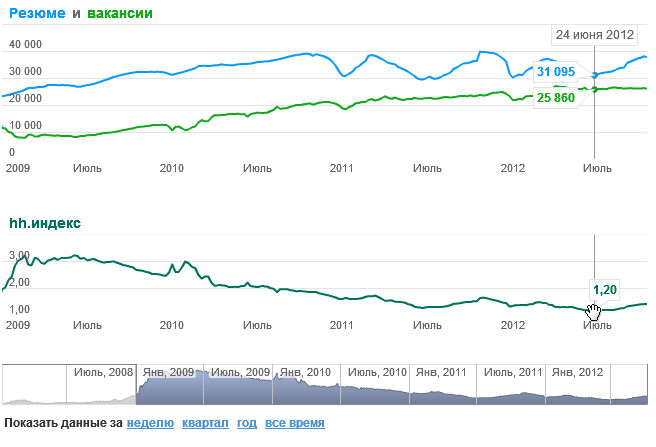
In a situation where there are many interesting offers, the main question for the IT specialist and, in particular, the programmer is the choice of the best one. And one of the main criteria here is salary.
Search clustering is an information tool for refining (narrowing) a query in search results. On hh.ru there are several clusters on the main parameters of the vacancy. Last put into operation just allows you to narrow the search for salary:
')
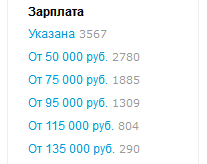 Salary clusters are built automatically based on a search query. All vacancies found are divided into 6 clusters with an indication of salaries and the number of open vacancies in the cluster. Accordingly, it is possible, by selecting a specific cluster, to view vacancies from it and recursively split them into smaller clusters.
Salary clusters are built automatically based on a search query. All vacancies found are divided into 6 clusters with an indication of salaries and the number of open vacancies in the cluster. Accordingly, it is possible, by selecting a specific cluster, to view vacancies from it and recursively split them into smaller clusters.
In addition to the function of narrowing the search, salary clusters have a serious information component. With their help, any user can make their own overview of the labor market for any search query.
For example, let's see how many vacancies are open at hh.ru for programmers in Russia:

I counted the number of vacancies for a certain period for salaries "from" and "to". On the site, all the clusters are considered “from”, since usually the applicant is interested in offers, from which specific amount.
Our partners and competitors offer statistics by region. No problem, just select the corresponding region in the search, for example, Moscow and get a picture that I placed before the search:

Here clusters are visualized, in which the distribution of wages is already similar to normal. In the first histogram, which displays data for Russia as a whole, in fact, the normal distribution is blurred by the difference in salaries between the capital and the regions, with the result that the first two clusters are so large.
In St. Petersburg, the distribution of salaries is similar:
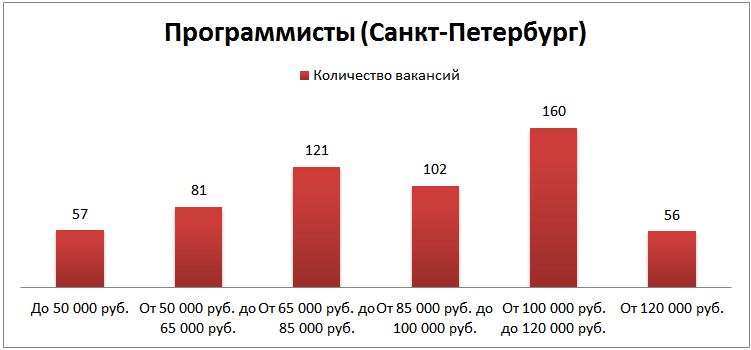
Accordingly, a number of interesting hypotheses can be made, in particular, it can be assumed (which is confirmed if you look at vacancies for specific clusters):
The main advantage of such a study is that we see the distribution of salaries, and not just the average salary, which is also useful as the average temperature in the hospital.
Now each reader can try to relate his salary and position, and employers can assess how well their salaries correspond to the market situation.

“Well, they promised something interesting and relevant to a specific person, but they tell about a spherical programmer in a vacuum,” the visionary reader will say and will be right. At the next stage of our small research, we will see how much a programming language costs. To do this, I will use queries with the name of the corresponding programming language with a search for the description and title of the vacancy (to build past histograms, I used the search only for the title of the vacancy). Such an approach slightly reduces the accuracy, because quite often in vacancies indicate the desired programming languages, i.e. actual results will be slightly lower. I do not analyze requests for HTML, JavaScript, and the like, because these words are often indicated as an additional option.
He chose Default City as the research city, as the largest in terms of the number of programmer vacancies. Programming languages I chose at my own discretion with a desktop / serverside orientation so that it could be, then connected with a DBMS. But all the selected languages are in the top 10 for TIOBE.
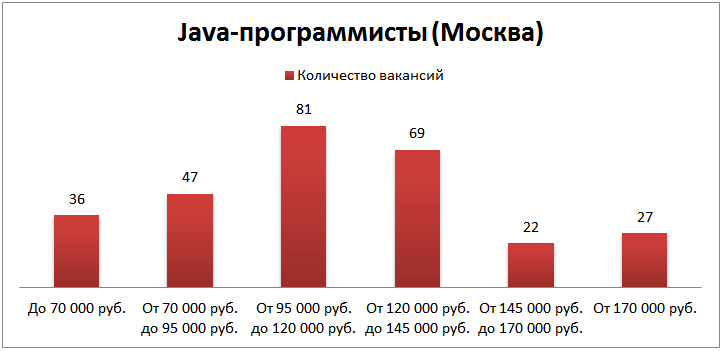
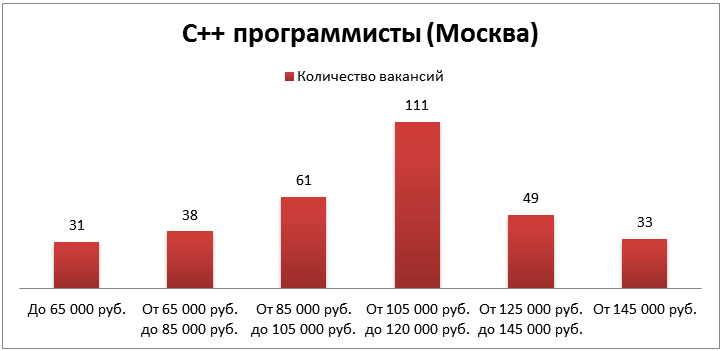
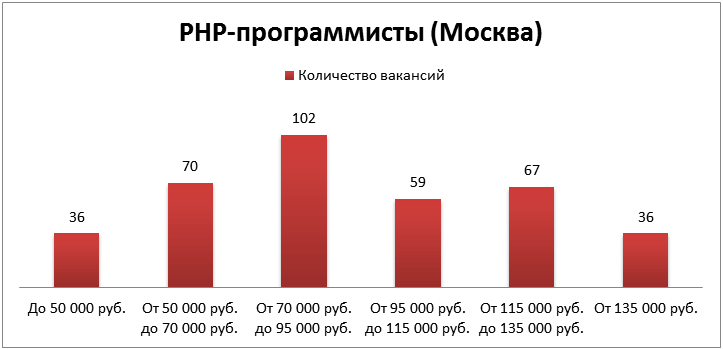

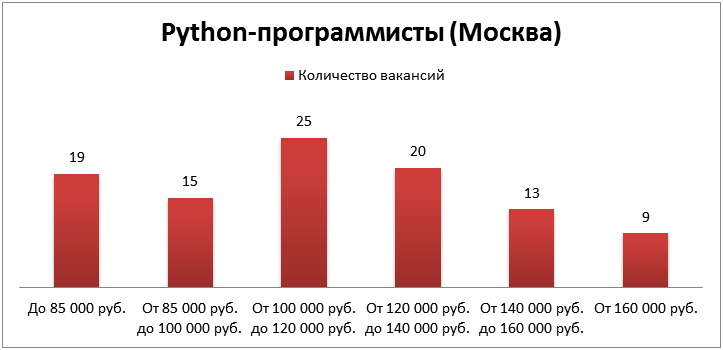
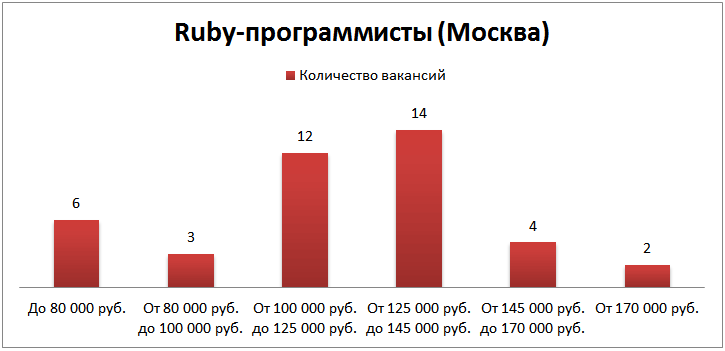


Now let's try the latest aerobatics: add additional technology to programming languages, for example, a database. Here I will shorten the list of programming languages a bit, since there are not suitable vacancies for everyone, and I will indicate salaries through a slash in thousands of rubles. The search queries corresponded to the name of the programming language and database (in the latter case, “NoSQL”):

Such a matrix can be used not only to understand its value, but also to plan your career. For example, imagine that I am an average PHP developer and work with the standard MySQL database. If I study well and get PostgreSQL experience, I can claim a salary of at least 15,000 rubles a month more.
All of the above studies can be repeated (and improved) in their region, programming language, technology, and so on.

Now in the IT labor market, applicants rule: it is enough to open your resume and immediately get a lot of offers. Our hh.index , which shows the ratio of the number of summaries to the number of vacancies, in the field of information technology in July fell in Moscow to a record value of 1.2 (at the peak in 2009, its value rose above 3):

In a situation where there are many interesting offers, the main question for the IT specialist and, in particular, the programmer is the choice of the best one. And one of the main criteria here is salary.
Salary Clusters
Search clustering is an information tool for refining (narrowing) a query in search results. On hh.ru there are several clusters on the main parameters of the vacancy. Last put into operation just allows you to narrow the search for salary:
')
 Salary clusters are built automatically based on a search query. All vacancies found are divided into 6 clusters with an indication of salaries and the number of open vacancies in the cluster. Accordingly, it is possible, by selecting a specific cluster, to view vacancies from it and recursively split them into smaller clusters.
Salary clusters are built automatically based on a search query. All vacancies found are divided into 6 clusters with an indication of salaries and the number of open vacancies in the cluster. Accordingly, it is possible, by selecting a specific cluster, to view vacancies from it and recursively split them into smaller clusters.In addition to the function of narrowing the search, salary clusters have a serious information component. With their help, any user can make their own overview of the labor market for any search query.
For example, let's see how many vacancies are open at hh.ru for programmers in Russia:

I counted the number of vacancies for a certain period for salaries "from" and "to". On the site, all the clusters are considered “from”, since usually the applicant is interested in offers, from which specific amount.
Our partners and competitors offer statistics by region. No problem, just select the corresponding region in the search, for example, Moscow and get a picture that I placed before the search:

Here clusters are visualized, in which the distribution of wages is already similar to normal. In the first histogram, which displays data for Russia as a whole, in fact, the normal distribution is blurred by the difference in salaries between the capital and the regions, with the result that the first two clusters are so large.
In St. Petersburg, the distribution of salaries is similar:

Accordingly, a number of interesting hypotheses can be made, in particular, it can be assumed (which is confirmed if you look at vacancies for specific clusters):
- Clusters 1 and 2 are Juniors;
- Clusters 3 and 4 are Regular Developper;
- Clusters 5 and 6 are Senior Developper.
The main advantage of such a study is that we see the distribution of salaries, and not just the average salary, which is also useful as the average temperature in the hospital.
Now each reader can try to relate his salary and position, and employers can assess how well their salaries correspond to the market situation.
Dive deeper

“Well, they promised something interesting and relevant to a specific person, but they tell about a spherical programmer in a vacuum,” the visionary reader will say and will be right. At the next stage of our small research, we will see how much a programming language costs. To do this, I will use queries with the name of the corresponding programming language with a search for the description and title of the vacancy (to build past histograms, I used the search only for the title of the vacancy). Such an approach slightly reduces the accuracy, because quite often in vacancies indicate the desired programming languages, i.e. actual results will be slightly lower. I do not analyze requests for HTML, JavaScript, and the like, because these words are often indicated as an additional option.
He chose Default City as the research city, as the largest in terms of the number of programmer vacancies. Programming languages I chose at my own discretion with a desktop / serverside orientation so that it could be, then connected with a DBMS. But all the selected languages are in the top 10 for TIOBE.
Java

C ++

Php

C #

Python

Ruby

Perl

Build a matrix or add a second dimension

Now let's try the latest aerobatics: add additional technology to programming languages, for example, a database. Here I will shorten the list of programming languages a bit, since there are not suitable vacancies for everyone, and I will indicate salaries through a slash in thousands of rubles. The search queries corresponded to the name of the programming language and database (in the latter case, “NoSQL”):

Such a matrix can be used not only to understand its value, but also to plan your career. For example, imagine that I am an average PHP developer and work with the standard MySQL database. If I study well and get PostgreSQL experience, I can claim a salary of at least 15,000 rubles a month more.
All of the above studies can be repeated (and improved) in their region, programming language, technology, and so on.
Source: https://habr.com/ru/post/155591/
All Articles